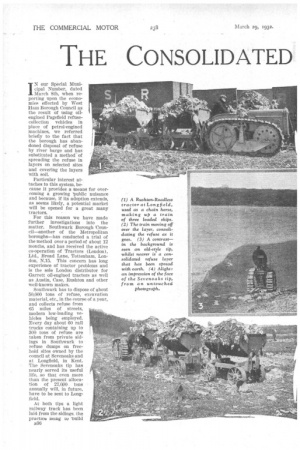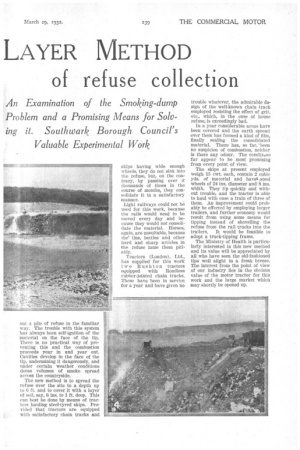THE CONSOLIDATED LAYER METHOD
Page 54

Page 55

If you've noticed an error in this article please click here to report it so we can fix it.
of refuse collection
An Examination of the Smoking-dump Problem and a Promising Means for Solv ing it. Southwark Borough Council's Valuable Experimental Work
IN our Special Municipal Number, dated March 8th, when reporting upon the economies effected by West Ilam Borough Council as the result of using oileugined Pagefield refusecollection vehicles in place of petrol-engined machines, we referred briefly to the fact that the borough has abandoned disposal of refuse by river barge and has substituted a method of spreading the refuse in layers on selected sites and covering the layers with soil.
Particular interest attaches to this system, because it provides a means for overcoming a growing 'public nuisance and because, if its adoption extends, as seems likely, a potential market will be opened for a great many tractors.
For this reason we have made further investigations into the matter. Southwark Borough nouncil—another of the Metropolitan boroughs—has conducted a trial of the method over a period of about 12 months, and has received the active co-operation of Tractors (London), Ltd., Broad Lane, Tottenham, London, N,15. This concern has long experience of tractor problems and is the sole London distributor for Garrett oil-engined tractors as well as Austin, Case, Rushton and other well-known makes.
Southwark has to dispose of about 50,000 tons of refuse, excavation material, etc., in the course of a year, and collects refuse from 65 miles of streets, modern low-loading vehicles being employed. Every day about 60 rail trucks containing up to 300 tons of refuse are taken from private sidings in Southwark to refuse dumps on freehold sites owned by the council at Sevenoaks and at Long-field, in Kent. The Sevenoaks tip has nearly served its useful life, so that even more than the present allocation of 27,000 tons annually will, in future, have to be sent to Longfield.
At both tips a light railway track has been laid from the sidings, the practice being to 'Duild E36 out a pile of refuse in the familiar way. The trouble with this system has always been self-ignition of the material on the face of the tip. There is no practical way of preventing this and the combustion proceeds year in and year out. Cavities develop in the face of the tip, undermining it dangerously, and under certain weather conditions dense volumes of smoke spread across the countryside.
The new method is to spread the refuse over the site to a depth up to 6 ft. and to cover it with a layer of soil, say, 6 ins. to 1 ft. deep. This can best be done by means of tractors hanling steel-tyred skips. Provided that tractors are equipped
with satisfactory chain tracks and "m77..
skips having wide enough wheels, they do not sink into the refuse, but, on the contrary, by passing over it thousands of times in the course of months, they consolidate it in a satisfactory manner.
Light railways could not be used for this work, because the rails would need to be moved every clay and because they would not consolidate the material. Horses, again, are unsuitable, because the tins, bottles and other hard and sharp articles in the refuse lame them pitiably.
Tractors (London), Ltd., has supplied for this work two Rus h't o n ' tractors equipped with Roadless rubber-jointed chain tracks. These have been in service for a year and have given no trouble whatever, the admirable design of the well-known chain track employed resisting the effect of grit, etc., which, in the ease of house refuse, is exceedingly bad.
In a year considerable areas have been covered and the earth spread over them has formed a kind of film, finally sealing the consolidated material. There has, so far, been no suspicion of combustion, neither is there any odour. The re5ults4so far appear to be most promising _ from every point of view.
The skips at present employed weigh 15 cwt. each, contain 2 cubic yds. of material and havet •steel wheels of 24 ins, diameter and i3 ins. width. They tip quickly and without trouble, and the tractor is able to haul with ease a train of three of them. An improvement could probably be effected by employing larger trailers, and further economy would result from using some means for tipping instead of shovelling the refuse from the rail trucks into the trailers. It would be feasible to adopt a truck-tipping frame.
The Ministry of Health is particularly interested in this new method and its value will be appreciated by all who have seen the old-fashioned tips well alight in a fresh breeze. The interest from the point of view of our industry lies in the obvious value of the motor tractor for this work and the large market which may shortly be opened up.




































































































